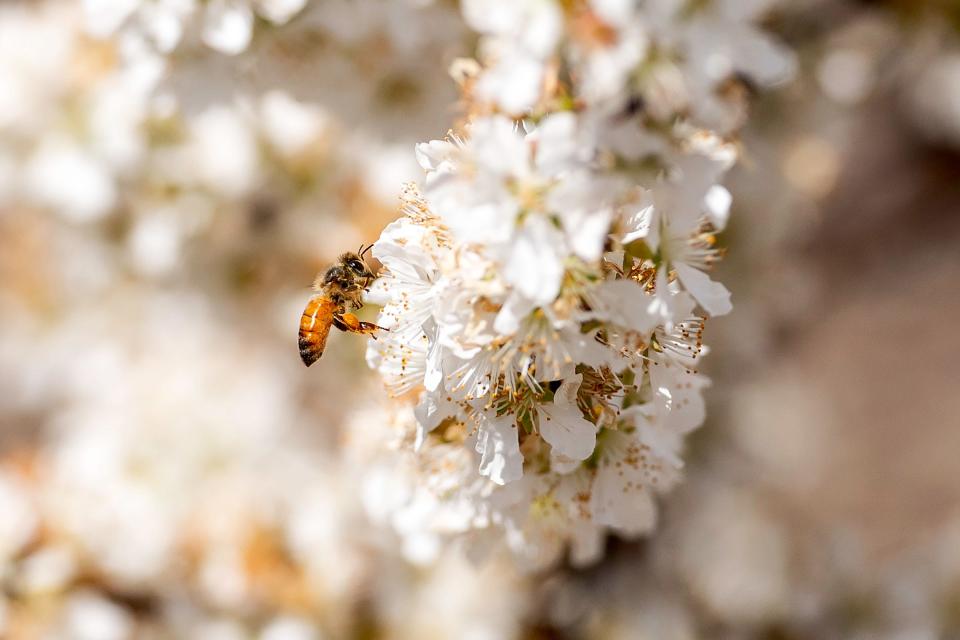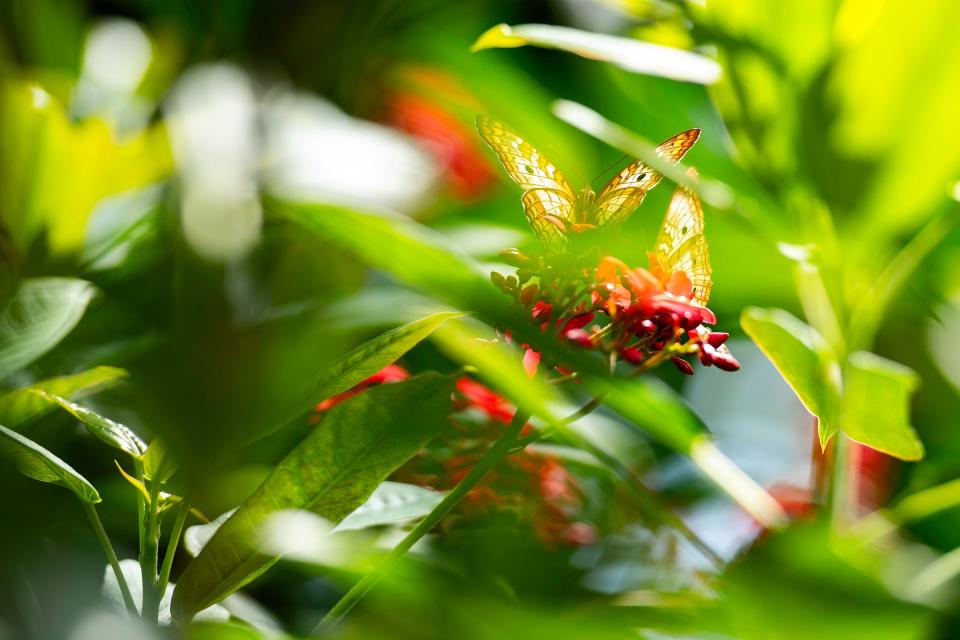Colorado has a pollinator problem. Here's how you can help bring back bees and butterflies
If you savor Palisade peaches, Rocky Ford melons and fresh vegetables from your home garden or enjoy beautiful flowers in your landscape, then this should be of concern.
Colorado’s pollinators are in trouble.
A University of Colorado study showed some of Colorado’s native pollinator populations have declined by 50% over the past 35 years.
The state-commissioned Native Pollinating Insects Protection Study to determine the health of Colorado's pollinators showed imperiled species of butterflies and bumble bees — and it indicated those species are likely the tip of the iceberg and a huge underestimate of the true scope of imperiled pollinator species.

The study pointed out numerous reasons for the native pollinator decline but cited habitat loss from the conversion of natural areas to agriculture or development as the biggest threat to pollinating insects.
That loss is important because Colorado is home to nearly 30% of North America’s bee species and 40% of butterfly species in the U.S. and Canada, and those are the prime pollinators of our plants.
Colorado has taken steps in recent years to make it easier for people to bring back pollinator populations through recent legislation, municipalities offering rebates for replacing lawns with low-water gardens and easy-to-use pollinator garden plans for homeowners.
Mike Tincher of Loveland has seen the value of turning areas of his landscape into pollinator gardens. He said doing so has beautified his landscape and increased his vegetable garden production while lowering water use.
"Once I started my bee gardens, it made all the difference in the world for my vegetable garden," he said. "And when you have bee gardens with tall plants not only do you attract pollinators, but it gives the grasshoppers a place to go and keeps them from places you don’t want them.''
How politics is helping pollinators in Colorado, including a specialty license plate

In recent years, the Colorado General Assembly has passed various bills to promote pollinators:
2023: SB23-178, Water-wise Landscaping In Homeowners' Association Communities, requires HOAs to allow at least three water-saving landscaping designs that single-family homeowners could choose from to eliminate grass. It also prohibits HOAs from banning vegetable gardens in front, back and side yards.
2022: Gov. Jared Polis signed a bill to fund the Native Pollinating Insects Protection Study, which assessed the health of Colorado’s native pollinators and created a priority list of actions needed to improve the health of our pollinators.
2021: HB21-1145, Support Pollinator Special License Plate, created a specialty license plate featuring a native Hunt’s bumblebee and blanket flower. A donation when you purchase the plate supports the nonprofit People and Pollinators Action Network.
Fort Collins, Loveland among cities offering rebates for replacing lawns with low-water gardens
In an effort to reduce water used on lawn grass, cities such as Fort Collins and Loveland offer rebates of up to $750 for residential landscapes and $15,000 for commercial properties to replace lawn grass with approved low-water landscape plans.
For Fort Collins, visit www.fcgov.com/utilities/residential/conserve/water-efficiency/xeriscape/incentive-program.
For Loveland, visit www.lovelandwaterandpower.org/resident/lawn-replacement-program.
"Getting HOAs onboard was important because now those people who want to replace grass with pollinator gardens can do so," Tincher said. "It not only helps the pollinators but also reduces water use."
That’s critical as 55% of residential water use along the Front Range goes towards the outdoors, mainly grass lawns.
Here's what you need to know to create and keep pollinators in your landscape
Here are the building blocks to attract and keep pollinators in your yard, according to various sources:
Pollinators need food, water, nesting areas, shelter and space to support robust populations.
If possible, situate gardens in sunny, open areas.
Provide plants that offer a succession of blooms early in the season until late.
Plant in groups of three or more and in layers, replicating nature. Begin by establishing a basic structure with trees and shrubs. Then add perennials, grasses, and groundcovers as further layers within the landscape.
Leave plant stems, fallen logs or stumps for bees, beetles and flies to use for nesting.
Allow some twigs and leaf litter to remain where they fall to provide overwinter shelter for many insect pollinators.
Leaving areas of bare soil for ground nesting bees, which are the bulk of our native bee population.
Reduce or eliminate pesticide use or use the least toxic product possible.
If you use pesticides, do so at night when bees and many other pollinators are not active.
Here are plants to use in your landscape to attract pollinators
These plants are readily available at most local nurseries or you can order them online. It's best to choose native plants if possible.
Many can take low water but use of a drip system helps establish new plants and helps established plants endure prolonged dry conditions resulting in better plant health.
Early season
Pawnee Buttes sandcherry (low-growing shrub)
Prairie winecups (low-growing perennial)
Sulphur flower (low-growing perennial)
Wallflower (medium to tall perennial)
Rocky Mountain and Firecracker penstemons (medium perennial)
Nodding onion (tall perennial)
Yarrow (medium to tall perennial)
Blue flax (medium to tall perennial)
Golden currant (medium shrub)
Serviceberry (small tree, large shrub)
Flowering fruit trees, including apples, cherries, peaches and plums
Midseason
Missouri evening primrose (low to medium perennial)
Hummingbird trumpet (low growing perennial)
Harebells (medium perennial)
Blanket flower (medium perennial)
May night salvia (medium perennial)
Coneflower (medium perennial)
Black-eyed Susan (medium perennial)
Asters (medium to tall perennial)
Showy milkweed (medium to tall perennial)
Flowering trees, including willows, black locust, linden and honey locust
Late season
Autumn Joy sedum (medium perennial)
Goldenrod (medium to tall perennial)
Hyssop (medium to tall perennial)
Plains Coreopsis (medium to tall perennial)
Rocky Mountain bee plant (tall perennial)
Common sunflower (tall annual)
Rabbitbrush (medium to tall shrub)
Chokecherry (tall shrub or tree)
Boulder raspberry (medium shrub)
Resource list for creating your pollinator garden
CSU Extension: Creating pollinator habitat, https://extension.colostate.edu/topic-areas/insects/creating-pollinator-habitat-5-616/
Resource Central: Garden in a Box low-water landscape designs, https://resourcecentral.org/gardens/
High Plains Environmental Center: Native plant sale
Colorado Native Plant Society: https://conps.org/
Plant Select: Low-water pollinator plants, https://plantselect.org/plants/our-plants/
High Country Gardens: Low-water pollinator plants, https://www.highcountrygardens.com/category/plant-finder/pollinator-plants
This article originally appeared on Fort Collins Coloradoan: Colorado's bees, butterflies are in trouble. Here's how you can help

